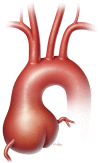Valve-sparing versus composite root replacement procedures in patients with Marfan syndrome
- PMID: 29270382
- PMCID: PMC5721102
- DOI: 10.21037/acs.2017.11.02
Valve-sparing versus composite root replacement procedures in patients with Marfan syndrome
Conflict of interest statement
Conflicts of Interest: Dr. Coselli serves as a consultant for Vascutek Ltd., a subsidiary of Terumo Corporation. The other authors have no conflicts of interest to declare.
Figures




References
-
- David TE, Feindel CM. An aortic valve-sparing operation for patients with aortic incompetence and aneurysm of the ascending aorta. J Thorac Cardiovasc Surg 1992;103:617-21; discussion 622. - PubMed
Publication types
LinkOut - more resources
Full Text Sources
Other Literature Sources
